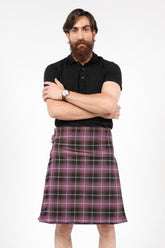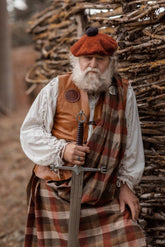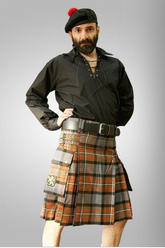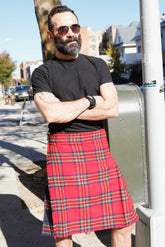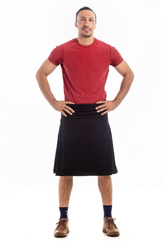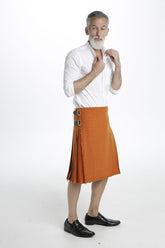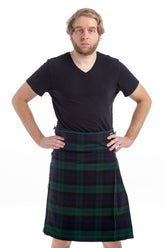451 results
20
- 10
- 15
- 20
- 25
- 30
- 50
Featured
- Featured
- Best selling
- Alphabetically, A-Z
- Alphabetically, Z-A
- Price, low to high
- Price, high to low
- Date, old to new
- Date, new to old
Sort
Sort by:
- Featured
- Best selling
- Alphabetically, A-Z
- Alphabetically, Z-A
- Price, low to high
- Price, high to low
- Date, old to new
- Date, new to old
-
Casual Kilt - 5 Yards
Unleash your Scottish heritage with our Premium 5 Yard Casual Kilt! Made from high-quality acrylic wool, customizable to your clan's tartan. Lightweight, stylish, and built to last. wear your tradition with pride!- $48.00
$59.00- $48.00
- Unit price
- / per
-
Traditional Kilt - 8 Yards
Make a bold statement at your next Highland Games, Formal events or weddings. Our 8-yard traditional kilt is the perfect blend of heritage and modern style. Choose your tartan, customize to fit, and stand out at any occasion.- $68.00
$89.00- $68.00
- Unit price
- / per
-
Great Kilt
Embrace the spirit of Scotland with our Great Kilt. Crafted with premium materials and authentic design, this timeless garment offers unmatched quality and style. Stand out at any occasion – experience the tradition today!- $79.00
$109.00- $79.00
- Unit price
- / per
-
Elegant Tartan Hiking Kilt
Gear up for adventure with our Hiking Kilt. Lightweight, durable, and stylish, it features an adjustable fit, spacious pockets, and breathable comfort—perfect for outdoor enthusiasts. Get yours and explore in style!- $59.00
$89.00- $59.00
- Unit price
- / per
-
Contemporary Comfy Kilt
Celebrate Scottish heritage in style with our Contemporary Comfy Kilt. Featuring modern design, custom tartans, and a lightweight, comfortable fit. Perfect for any occasion. Order now and bring tradition into the present!- $59.00
$79.00- $59.00
- Unit price
- / per
-
Celtic Punk Kilt
Stand out with our Celtic Punk Kilt! A bold fusion of two tartan patterns, crafted from high-quality acrylic wool. Customizable, stylish, and functional with hidden pockets. Get yours today and showcase your unique style!- $55.00
$64.00- $55.00
- Unit price
- / per
-
Classic Black Kilt
The Classic Black Kilt features a sleek black tartan, knife pleats for easy movement, and an adjustable leather strap for a custom fit. Durable, comfortable, and perfect for any occasion. Order now for timeless style and quality!- $59.00
$89.00- $59.00
- Unit price
- / per
-
Saffron Tartan Kilt
Celebrate Irish heritage with our Saffron Kilt, featuring vibrant orange tartan. Made from durable acrylic wool with custom fit options, it's perfect for any occasion. Order now for a blend of tradition and modern comfort!- $69.00
$99.00- $69.00
- Unit price
- / per
-
Black Watch Tartan Kilt
Embrace Scottish heritage with the Black Watch Tartan Kilt, crafted from durable acrylic wool and featuring the iconic Black Watch pattern. Perfect for formal occasions, it offers a timeless blend of tradition and elegance.- $48.00
$69.00- $48.00
- Unit price
- / per
-
Abel Tartan Kilt
The Abel tartan, often associated with the Scottish Highlands, has no long-established historical link to a specific clan, as the Abel surname is less prominent in tartan records. However, the Abel name appears in various regions of Scotland, particularly in Aberdeenshire. Modern Abel tartans...- $58.00
$89.00- $58.00
- Unit price
- / per
-
Armstrong Tartan Kilt
The Armstrong Tartan is linked to the Armstrong clan, a Scottish family with a long history in the Borders region, where they were known for their warrior spirit and strategic importance. The clan's roots date back to the medieval period, and they played a...- $48.00
$79.00- $48.00
- Unit price
- / per
-
Ailsa Pink Tartan Kilt
In Scotland, the Clan of Ailsa Pink Tartan has a fascinating and varied history that dates back to ancient times. The beginning of the Ailsa faction is believed to have been established in the early medieval period when numerous prominent families in Scotland were...- $48.00
$79.00- $48.00
- Unit price
- / per
-
Anderson Tartan Kilt
The Anderson Tartan Kilt is a classic and timeless piece that celebrates Scottish heritage, associated with anderson clan, originally known as "MacAndrew," traces its origins to the ancient Pictish people of Scotland. Renowned for their intellect and education, the Andersons played significant roles in...- $48.00
$79.00- $48.00
- Unit price
- / per
-
Andover Tartan Kilt
The Andover name is historically associated with the town of Andover in Hampshire, England, which dates back to Anglo-Saxon times. The Andover clan is one of the leading clans to have settled in the United Kingdom of Scotland. With roots tracing back to ancient...- $48.00
$79.00- $48.00
- Unit price
- / per
-
Banff & Buchan District Tartan Kilt
The Banff & Buchan District, located in the northeastern part of Scotland, is known for its picturesque landscapes and rich history. The district’s clans, including the prominent Banff clan, have deep roots in the region’s agricultural and maritime industries. Banff & Buchan played an...- $68.00
$99.00- $68.00
- Unit price
- / per
-
Buchanan Tartan Kilt
The Buchanan clan, one of Scotland's oldest, traces its origins to the 13th century. Renowned for its resilience and valor, the clan played significant roles in various historical events, including the Wars of Scottish Independence. A notable figure is Sir Alexander Buchanan, who famously...- $48.00
$69.00- $48.00
- Unit price
- / per
-
California State Tartan Kilt
The California State tartan was officially designated in 2001 to honor the state’s rich Scottish heritage and the contributions of Scots to California's history. The tartan symbolizes the unity and pride of Californians with Scottish ancestry and serves as a cultural link, reflecting the...- $58.00
$89.00- $58.00
- Unit price
- / per
-
Clergy Tartan Kilt
The Clergy Kilt represents a special tradition in Scotland where members of the clergy were distinguished by wearing their own tartan, separate from the clan system. This unique tartan reflects the significant role of religious leaders in Scottish society, particularly during times of social...- $58.00
$89.00- $58.00
- Unit price
- / per
-
Freedom Tartan Kilt
The Freedom Tartan kilt is made of freedom tartan, which embodies the rich history and spirit of Scotland, reflecting its vibrant landscapes and storied heritage. The Freedom tartan was designed to symbolize the universal ideals of liberty and human rights, rather than being tied...- $48.00
$79.00- $48.00
- Unit price
- / per
-
Cornish Tartan Kilt
Chris Gower, a Cornishman, invented Cornish tartan at the end of the 20th century. Though Cornwall lacks formal clans, its people share a deep connection to their ancient traditions and regional pride. The unique culture and heritage of Cornwall, a Celtic region in the...- $48.00
$79.00- $48.00
- Unit price
- / per


